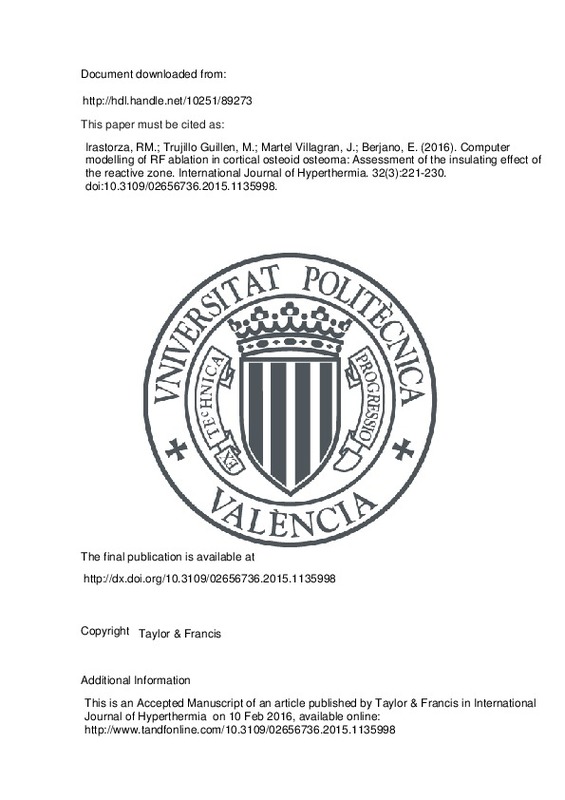JavaScript is disabled for your browser. Some features of this site may not work without it.
Buscar en RiuNet
Listar
Mi cuenta
Estadísticas
Ayuda RiuNet
Admin. UPV
Computer modelling of RF ablation in cortical osteoid osteoma: Assessment of the insulating effect of the reactive zone
Mostrar el registro sencillo del ítem
Ficheros en el ítem
| dc.contributor.author | Irastorza, Ramiro M.
|
es_ES |
| dc.contributor.author | Trujillo Guillen, Macarena
|
es_ES |
| dc.contributor.author | Martel Villagran, Jose
|
es_ES |
| dc.contributor.author | Berjano, Enrique
|
es_ES |
| dc.date.accessioned | 2017-10-17T09:46:13Z | |
| dc.date.available | 2017-10-17T09:46:13Z | |
| dc.date.issued | 2016-02-10 | |
| dc.identifier.issn | 0265-6736 | |
| dc.identifier.uri | http://hdl.handle.net/10251/89273 | |
| dc.description | This is an Accepted Manuscript of an article published by Taylor & Francis in International Journal of Hyperthermia on 10 Feb 2016, available online: http://www.tandfonline.com/10.3109/02656736.2015.1135998 | es_ES |
| dc.description.abstract | Purpose: The aim was to study by computer simulations the insulating role of the reactive zone surrounding a cortical osteoid osteoma (OO) in terms of electrical and thermal performance during radiofrequency ablation (RFA). Material and methods: We modelled a cortical OO consisting of a nidus (10 mm diameter) enclosed by a reactive zone. The OO was near a layer of cortical bone 1.5 mm thick. Trabecular bone partially surrounds the OO and there was muscle around the cortical bone layer. We modelled RF ablations with a noncooled-tip 17-gauge needle electrode (300 s duration and 90 C target temperature). Sensitivity analyses were conducted assuming a reactive zone electrical conductivity value (rz) within the limits of the cortical and trabecular bone, i.e. 0.02 S/m and 0.087 S/m, respectively. In this way we were really modelling the different degrees of osteosclerosis associated with the reactive zone. Results: The presence of the reactive zone drastically reduced the maximum temperature reached outside it. The temperature drop was proportional to the thickness of the reactive zone: from 68 C when it was absent to 44 C when it is 7.5 mm thick. Higher nidus conductivity values (n) implied higher temperatures, while lower temperatures meant higher rz values. Changing rz from 0.02 S/m to 0.087 S/m reduced lesion diameters from 2.4 cm to 1.8 cm. Conclusions: The computer results suggest that the reactive zone plays the role of insulator in terms of reducing the temperature in the surrounding area. Keywor | es_ES |
| dc.description.sponsorship | This work was supported by a grant from the Agencia Nacional de Promocion Cientifica y Tecnologica de Argentina (Ref. PICT-2012-1201), and by the Spanish Programa Estatal de Investigacion, Desarrollo e Innovacion Orientada a los Retos de la Sociedad under grant number TEC2014-52383-C3-R (TEC2014-52383-C3-1-R). The authors alone are responsible for the content and writing of the paper. | en_EN |
| dc.language | Inglés | es_ES |
| dc.publisher | Taylor & Francis | es_ES |
| dc.relation.ispartof | International Journal of Hyperthermia | es_ES |
| dc.rights | Reserva de todos los derechos | es_ES |
| dc.subject | Computer modeling | es_ES |
| dc.subject | Cortical bone | es_ES |
| dc.subject | Finite element method | es_ES |
| dc.subject | Osteoid osteoma | es_ES |
| dc.subject | Radiofrequency ablation | es_ES |
| dc.subject | Reactive zone | es_ES |
| dc.subject.classification | MATEMATICA APLICADA | es_ES |
| dc.subject.classification | TECNOLOGIA ELECTRONICA | es_ES |
| dc.title | Computer modelling of RF ablation in cortical osteoid osteoma: Assessment of the insulating effect of the reactive zone | es_ES |
| dc.type | Artículo | es_ES |
| dc.identifier.doi | 10.3109/02656736.2015.1135998 | |
| dc.relation.projectID | info:eu-repo/grantAgreement/ANPCyT//PICT-2012-1201/AR/Simulación y evaluación de propiedades dieléctricas de tejidos óseos/ | es_ES |
| dc.relation.projectID | info:eu-repo/grantAgreement/MINECO//TEC2014-52383-C3-1-R/ES/TECNOLOGIAS BASADAS EN ENERGIA DE RADIOFRECUENCIA Y MICROONDAS PARA CIRUGIA DE MINIMA INVASION/ | es_ES |
| dc.rights.accessRights | Abierto | es_ES |
| dc.contributor.affiliation | Universitat Politècnica de València. Escuela Técnica Superior de Ingeniería del Diseño - Escola Tècnica Superior d'Enginyeria del Disseny | es_ES |
| dc.contributor.affiliation | Universitat Politècnica de València. Escuela Técnica Superior de Arquitectura - Escola Tècnica Superior d'Arquitectura | es_ES |
| dc.description.bibliographicCitation | Irastorza, RM.; Trujillo Guillen, M.; Martel Villagran, J.; Berjano, E. (2016). Computer modelling of RF ablation in cortical osteoid osteoma: Assessment of the insulating effect of the reactive zone. International Journal of Hyperthermia. 32(3):221-230. https://doi.org/10.3109/02656736.2015.1135998 | es_ES |
| dc.description.accrualMethod | S | es_ES |
| dc.relation.publisherversion | http://dx.doi.org/10.3109/02656736.2015.1135998 | es_ES |
| dc.description.upvformatpinicio | 221 | es_ES |
| dc.description.upvformatpfin | 230 | es_ES |
| dc.type.version | info:eu-repo/semantics/publishedVersion | es_ES |
| dc.description.volume | 32 | es_ES |
| dc.description.issue | 3 | es_ES |
| dc.relation.senia | 313441 | es_ES |
| dc.identifier.pmid | 26862788 | |
| dc.contributor.funder | Ministerio de Economía y Competitividad | es_ES |
| dc.contributor.funder | Agencia Nacional de Promoción Científica y Tecnológica, Argentina | es_ES |







![[Cerrado]](/themes/UPV/images/candado.png)

